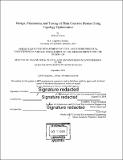| dc.contributor.advisor | Josephine Voigt Carstensen. | en_US |
| dc.contributor.author | Jewett, Jackson (Jackson Lee) | en_US |
| dc.contributor.other | Massachusetts Institute of Technology. Department of Civil and Environmental Engineering. | en_US |
| dc.date.accessioned | 2019-03-01T19:53:43Z | |
| dc.date.available | 2019-03-01T19:53:43Z | |
| dc.date.copyright | 2018 | en_US |
| dc.date.issued | 2018 | en_US |
| dc.identifier.uri | http://hdl.handle.net/1721.1/120634 | |
| dc.description | Thesis: M. Eng., Massachusetts Institute of Technology, Department of Civil and Environmental Engineering, 2018. | en_US |
| dc.description | Cataloged from PDF version of thesis. Page 45 blank. | en_US |
| dc.description | Includes bibliographical references (pages 43-44). | en_US |
| dc.description.abstract | Topology optimization is a structural design tool that can autonomously generate efficient forms within a design domain by ascribing fabrication material to key locations of a structure while removing it from underutilized areas. It has been known to lead to new design solutions that outperform conventional low-weight designs. This has made topology optimization a popular design tool for a wide range of applications, but examples related to civil structures such as buildings, bridges, or infrastructure remain limited. This is partly because topology optimization is a free-form design technique, and often produces complex, nonlinear designs that would be difficult to fabricate on a buildings-scale. However, this tendency suggests that concrete could be an excellent building material for topology-optimized civil structures, since its initial liquid phase makes it highly formable, and it's low cost and high strength make it a ubiquitous construction material. Materially-specific topology optimization algorithms have been suggested to account for the anisotropic behavior of reinforced concrete, however they have focused on developing strut-and-tie models and improving the damage strength of the design. At current, the validity of these algorithms remains uncertain as no designs have yet been fabricated and tested. This thesis therefore presents tests of plain concrete members designed using two different topology optimization algorithms that make different assumptions about the fabrication material's behavior, and compares their performance. Although plain concrete is rarely used on a structural scale, these initial experiments were designed without reinforcement to more clearly observe how these design algorithms reckon with the complex behavior of concrete. It was found that an algorithm specifically programmed to optimize plain concrete designed specimens that failed at lower maximum forces than beams designed with an algorithm that was not materially specific. It is likely that this result is due to optimization output rounding that was necessary to produce manufacturable designs. The information obtained from these tests is intended to inform topology optimization algorithms of reinforced concrete in future research. | en_US |
| dc.description.statementofresponsibility | by Jackson Jewett. | en_US |
| dc.format.extent | 45 pages | en_US |
| dc.language.iso | eng | en_US |
| dc.publisher | Massachusetts Institute of Technology | en_US |
| dc.rights | MIT theses are protected by copyright. They may be viewed, downloaded, or printed from this source but further reproduction or distribution in any format is prohibited without written permission. | en_US |
| dc.rights.uri | http://dspace.mit.edu/handle/1721.1/7582 | en_US |
| dc.subject | Civil and Environmental Engineering. | en_US |
| dc.title | Design, fabrication, and testing of plain concrete beams using topology optimization | en_US |
| dc.type | Thesis | en_US |
| dc.description.degree | M. Eng. | en_US |
| dc.contributor.department | Massachusetts Institute of Technology. Department of Civil and Environmental Engineering | |
| dc.identifier.oclc | 1086612723 | en_US |
